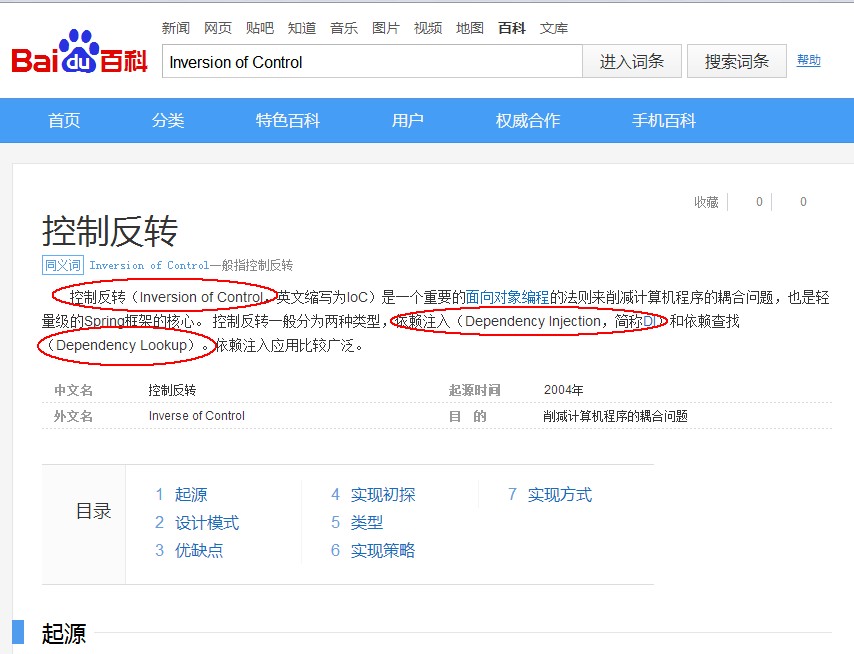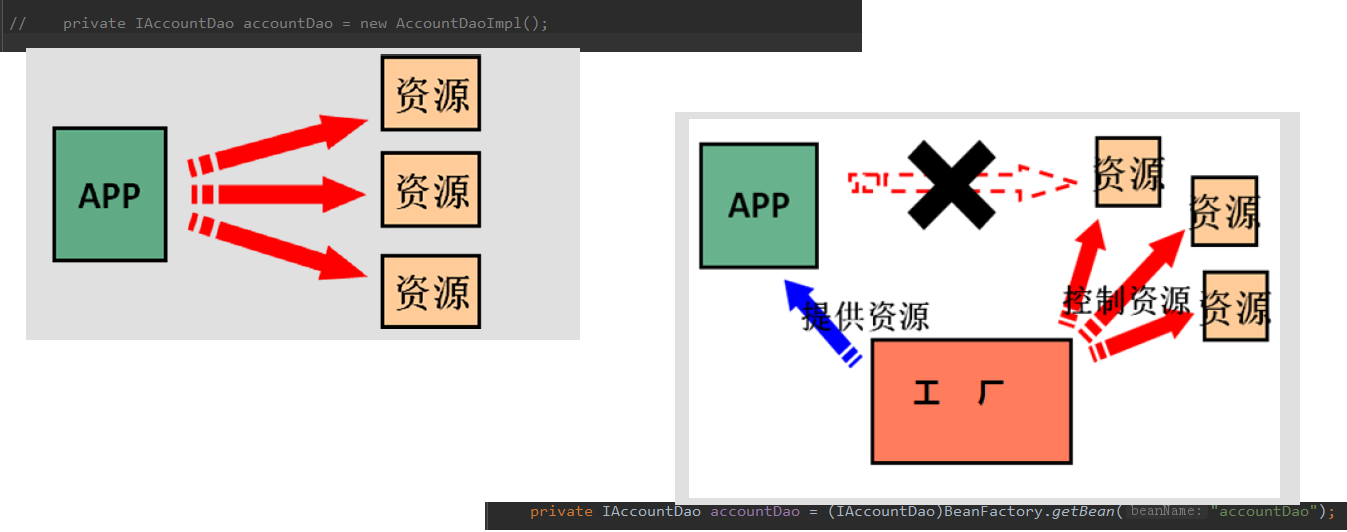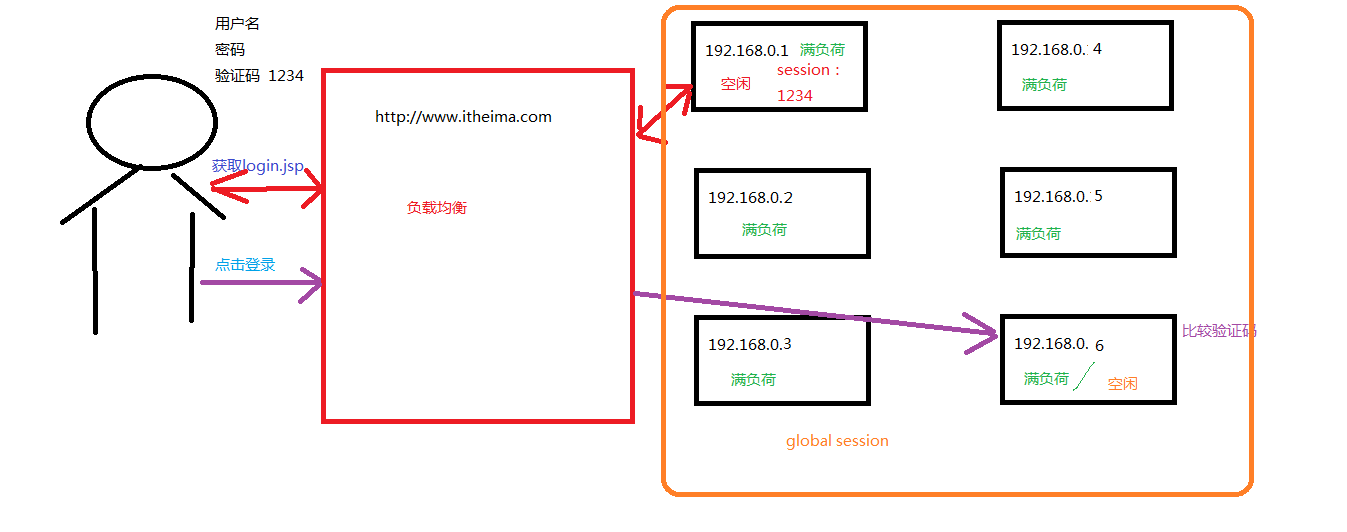1 ioc的概念和作用
作用: 降低程序间的依赖关系
获取spring的Ioc核心容器,并根据id获取对象



2 ApplicationContext的三个实现类
ApplicationContext的三个常用实现类:
(1)ClassPathXmlApplicationContext:它可以加载类路径下的配置文件,要求配置文件必须在类路径下。不在的话,加载不了。(更常用)
(2)FileSystemXmlApplicationContext:它可以加载磁盘任意路径下的配置文件(必须有访问权限)
(3)AnnotationConfigApplicationContext:它是用于读取注解创建容器
3 BeanFactory和ApplicationContext的区别
核心容器的两个接口引发出的问题:
ApplicationContext: 单例对象适用 采用此接口
它在构建核心容器时,创建对象采取的策略是采用立即加载的方式。也就是说,只要一读取完配置文件马上就创建配置文件中配置的对象。
BeanFactory: 多例对象使用
它在构建核心容器时,创建对象采取的策略是采用延迟加载的方式。也就是说,什么时候根据id获取对象了,什么时候才真正的创建对象。
public class Client { public static void main(String[] args) { //1.获取核心容器对象 ApplicationContext ac = new ClassPathXmlApplicationContext("bean.xml"); // ApplicationContext ac = new FileSystemXmlApplicationContext("C:\\Users\\zhy\\Desktop\\bean.xml"); //2.根据id获取Bean对象 IAccountService as = (IAccountService)ac.getBean("accountService"); IAccountDao adao = ac.getBean("accountDao",IAccountDao.class); System.out.println(as); System.out.println(adao); as.saveAccount(); //--------BeanFactory---------- // Resource resource = new ClassPathResource("bean.xml"); // BeanFactory factory = new XmlBeanFactory(resource); // IAccountService as = (IAccountService)factory.getBean("accountService"); // System.out.println(as); } }
4 spring中bean的细节之三种创建Bean对象的方式
<!--创建Bean的三种方式 -->
<!-- 第一种方式:使用默认构造函数创建。
在spring的配置文件中使用bean标签,配以id和class属性之后,且没有其他属性和标签时。
采用的就是默认构造函数创建bean对象,此时如果类中没有默认构造函数,则对象无法创建。
<bean id="accountService" class="service.impl.AccountServiceImpl"></bean>
-->
<!-- 第二种方式: 使用普通工厂中的方法创建对象(使用某个类中的方法创建对象,并存入spring容器)
<bean id="instanceFactory" class="factory.InstanceFactory"></bean>
<bean id="accountService" factory-bean="instanceFactory" factory-method="getAccountService"></bean>
-->
/** * 模拟一个工厂类(该类可能是存在于jar包中的,我们无法通过修改源码的方式来提供默认构造函数) */ public class InstanceFactory { public IAccountService getAccountService(){ return new AccountServiceImpl(); } }
<!-- 第三种方式:使用工厂中的静态方法创建对象(使用某个类中的静态方法创建对象,并存入spring容器)
<bean id="accountService" class="factory.StaticFactory" factory-method="getAccountService"></bean>
-->
/** * 模拟一个工厂类(该类可能是存在于jar包中的,我们无法通过修改源码的方式来提供默认构造函数) */ public class StaticFactory { public static IAccountService getAccountService(){ return new AccountServiceImpl(); -- } }
5 spring中bean的细节之作用范围
<!-- bean的作用范围调整
bean标签的scope属性:
作用:用于指定bean的作用范围
取值: 常用的就是单例的和多例的
singleton:单例的(默认值)
prototype:多例的
request:作用于web应用的请求范围
session:作用于web应用的会话范围
global-session:作用于集群环境的会话范围(全局会话范围),当不是集群环境时,它就是session

6 spring中bean的细节之生命周期
<!-- bean对象的生命周期
单例对象
出生:当容器创建时对象出生
活着:只要容器还在,对象一直活着
死亡:容器销毁,对象消亡
总结:单例对象的生命周期和容器相同
多例对象
出生:当我们使用对象时spring框架为我们创建
活着:对象只要是在使用过程中就一直活着。
死亡:当对象长时间不用,且没有别的对象引用时,由Java的垃圾回收器回收
-->
<?xml version="1.0" encoding="UTF-8"?> <beans xmlns="http://www.springframework.org/schema/beans" xmlns:xsi="http://www.w3.org/2001/XMLSchema-instance" xsi:schemaLocation="http://www.springframework.org/schema/beans http://www.springframework.org/schema/beans/spring-beans.xsd"> <bean id="accountService" class="com.itheima.service.impl.AccountServiceImpl" scope="prototype"></bean> --> <bean id="accountService" class="com.itheima.service.impl.AccountServiceImpl" scope="prototype" init-method="init" destroy-method="destroy"></bean> </beans>
7 spring的依赖注入
依赖注入:
Dependency Injection
IOC的作用:
降低程序间的耦合(依赖关系)
依赖关系的管理:
以后都交给spring来维护
在当前类需要用到其他类的对象,由spring为我们提供,我们只需要在配置文件中说明
依赖关系的维护:
就称之为依赖注入。
依赖注入:
能注入的数据:有三类
基本类型和String
其他bean类型(在配置文件中或者注解配置过的bean)
复杂类型/集合类型
注入的方式:有三种
第一种:使用构造函数提供
第二种:使用set方法提供
第三种:使用注解提供(明天的内容)
8 构造函数注入
<!--构造函数注入: 使用的标签:constructor-arg 标签出现的位置:bean标签的内部 标签中的属性 type:用于指定要注入的数据的数据类型,该数据类型也是构造函数中某个或某些参数的类型 index:用于指定要注入的数据给构造函数中指定索引位置的参数赋值。索引的位置是从0开始 name:用于指定给构造函数中指定名称的参数赋值 常用的 =============以上三个用于指定给构造函数中哪个参数赋值=============================== value:用于提供基本类型和String类型的数据 ref:用于指定其他的bean类型数据。它指的就是在spring的Ioc核心容器中出现过的bean对象 优势: 在获取bean对象时,注入数据是必须的操作,否则对象无法创建成功。 弊端: 改变了bean对象的实例化方式,使我们在创建对象时,如果用不到这些数据,也必须提供。 --> <bean id="accountService" class="com.itheima.service.impl.AccountServiceImpl"> <constructor-arg name="name" value="泰斯特"></constructor-arg> <constructor-arg name="age" value="18"></constructor-arg> <constructor-arg name="birthday" ref="now"></constructor-arg> </bean> <!-- 配置一个日期对象 --> <bean id="now" class="java.util.Date"></bean>
9 set方法注入
<!-- set方法注入 更常用的方式 涉及的标签:property 出现的位置:bean标签的内部 标签的属性 name:用于指定注入时所调用的set方法名称 value:用于提供基本类型和String类型的数据 ref:用于指定其他的bean类型数据。它指的就是在spring的Ioc核心容器中出现过的bean对象 优势: 创建对象时没有明确的限制,可以直接使用默认构造函数 弊端: 如果有某个成员必须有值,则获取对象是有可能set方法没有执行。 --> <bean id="accountService2" class="com.itheima.service.impl.AccountServiceImpl2"> <property name="name" value="TEST" ></property> <property name="age" value="21"></property> <property name="birthday" ref="now"></property> </bean>
10 注入集合数据
<!-- 复杂类型的注入/集合类型的注入 用于给List结构集合注入的标签: list array set 用于个Map结构集合注入的标签: map props 结构相同,标签可以互换 --> <bean id="accountService3" class="com.itheima.service.impl.AccountServiceImpl3"> <property name="myStrs"> <set> <value>AAA</value> <value>BBB</value> <value>CCC</value> </set> </property> <property name="myList"> <array> <value>AAA</value> <value>BBB</value> <value>CCC</value> </array> </property> <property name="mySet"> <list> <value>AAA</value> <value>BBB</value> <value>CCC</value> </list> </property> <property name="myMap"> <props> <prop key="testC">ccc</prop> <prop key="testD">ddd</prop> </props> </property> <property name="myProps"> <map> <entry key="testA" value="aaa"></entry> <entry key="testB"> <value>BBB</value> </entry> </map> </property> </bean>
public class AccountServiceImpl3 implements IAccountService { private String[] myStrs; private List<String> myList; private Set<String> mySet; private Map<String,String> myMap; private Properties myProps; public void setMyStrs(String[] myStrs) { this.myStrs = myStrs; } public void setMyList(List<String> myList) { this.myList = myList; } public void setMySet(Set<String> mySet) { this.mySet = mySet; } public void setMyMap(Map<String, String> myMap) { this.myMap = myMap; } public void setMyProps(Properties myProps) { this.myProps = myProps; } public void saveAccount(){ System.out.println(Arrays.toString(myStrs)); System.out.println(myList); System.out.println(mySet); System.out.println(myMap); System.out.println(myProps); } }